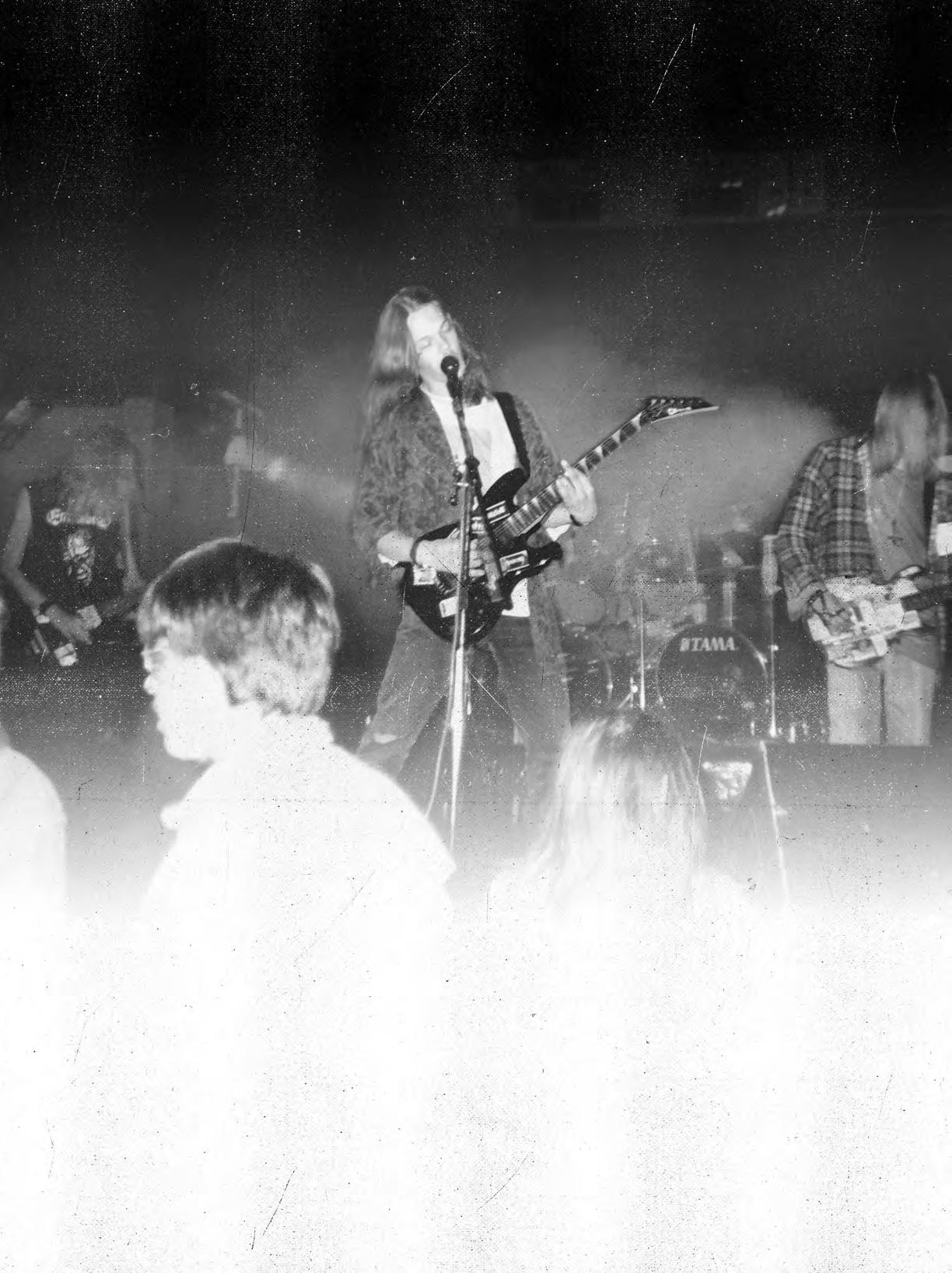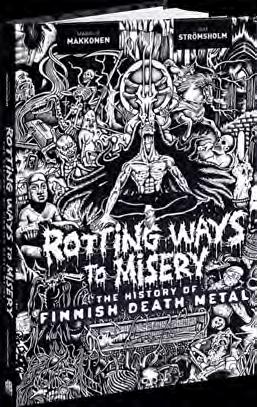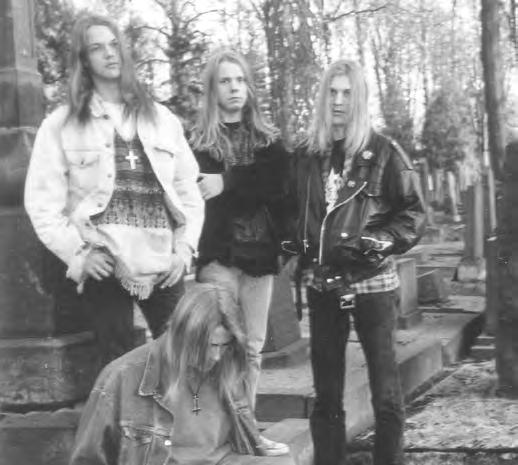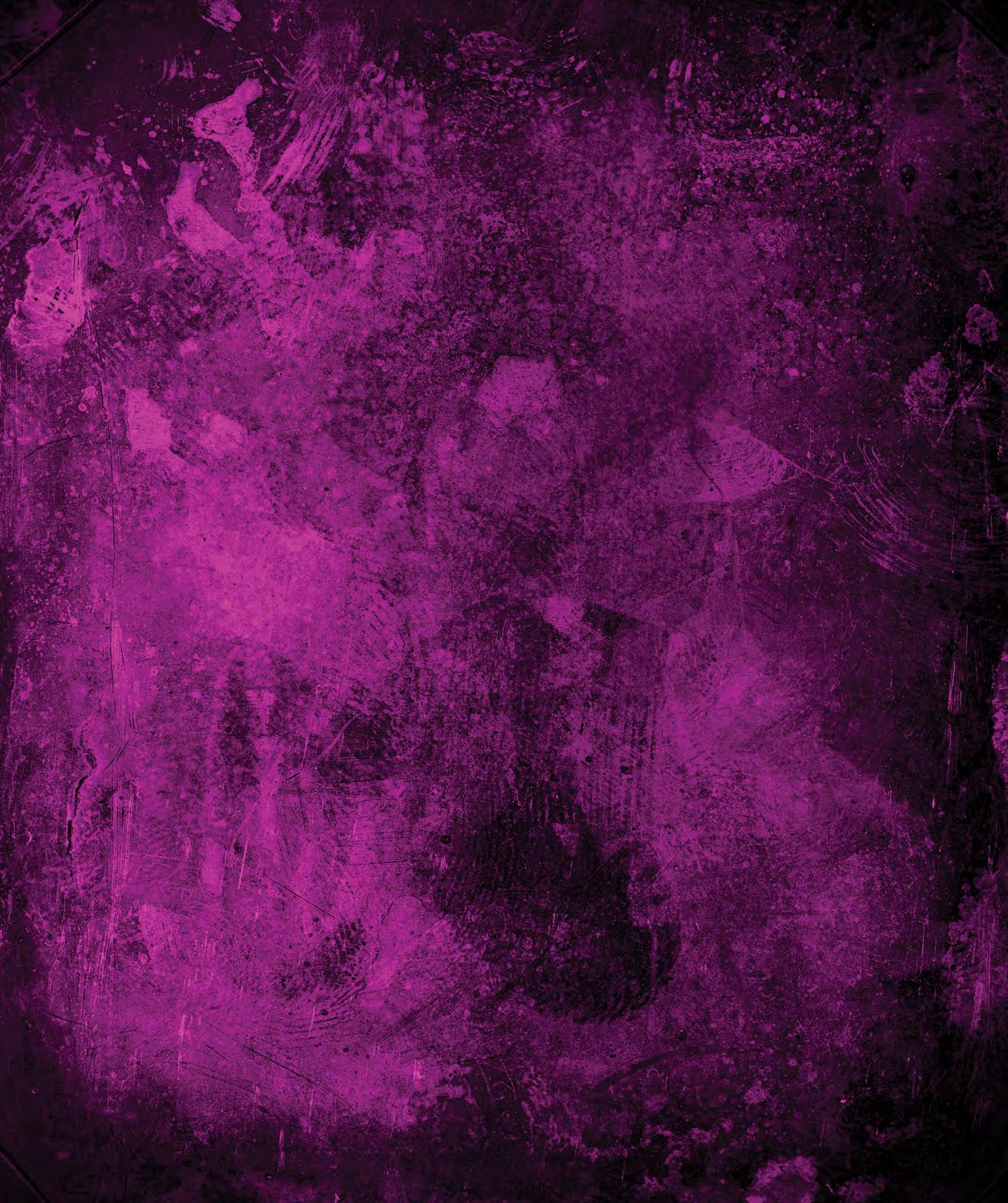
11 minute read
exclusive
AMORPHIS’ transition from ABHORRENCE is detailed in this rOtTiNG WaYS TO MIsERy
The History of Finnish Death Metal
book excerpt

IN APRIL,
Decibel Books will proudly publish the U.S. version of Rotting Ways To Misery: The History of Finnish Death Metal. Co-authored by Markus Makkonen (Sadistik Forest, Nerve Saw, Hooded Menace) and Kim Strömsholm (Festerday, ...And Oceans, Havoc Unit), this 362-page hardcover dives deep into the unique and sometimes overlooked late ’80s and early ’90s Finnish death metal scene. While you’ll get the full histories of underground heroes like Funebre, Purtenance and Mordicus in the book, for this exclusive excerpt, Makkonen and Strömsholm examine the earliest days of the scene’s biggest
A nebulous evil Demo-era Amorphis. Photo supplied by Mikko Mattila.

After Tomi Koivusaari left Violent Solution, the band kept going. They recorded a demo with Esa Holopainen on guitar, Period of Depression, in 1990, and it was followed in the same year with a more technically advanced EP entitled Paralysis/Individual Nightmare. Even though Violent Solution had taken huge steps forward as a band and were making a name for themselves in the live scene of the time, Abhorrence were not the only band in the neighborhood struggling with motivational problems.
“Violent Solution just simply died,” Holopainen says. “There was only the second half of it left, really. One guy was maybe more interested in his moped than being in the band, and the other dude was not far from that either. They simply were not into it any longer. We just kept playing old songs. Then [myself and Jan ‘Snoopy’ Rechberger] formed a new band. Simple as that.”
After Koivusaari’s departure from Violent Solution, death metal fandom had reached Holopainen and Rechberger as well. It was clear to the remaining duo that the new band would not be thrash or speed metal. Rechberger switched to drums and they started to figure out a completely new kind of musical approach, for a completely new kind of band.
“He had been thinking of drumming for a long time and finally got himself a kit,” Holopainen remembers. “We did not have anybody else in the band at the time. We knew Oppu from the Helsinki scene, and he had Nuxvomica—a sort of a death metal band—himself. We asked if he would be interested in joining the group.”
Olli-Pekka “Oppu” Laine did not hesitate. “I knew Jan and Esa through Violent Solution,” he says. “When they split up, Esa called me up and said they were looking for a bass player for a band they were putting together. At the time, Abhorrence was still up and running, but they had asked Tomi to be their singer. I thought I might give the band a go, and it worked out really well, right from the very first rehearsals.”
Koivusaari had been doing some backing vocals at Abhorrence gigs already, and discovered that he was a natural at the savage death metal growl. So, the proposition to do vocals in the group of his old bandmate and lifetime friend Snoopy felt like an interesting one.
“If I remember right, the material Esa had written was still a bit of a thrashy kind of death metal,” Laine says, “somewhere between Violent Solution and Abhorrence. Not proper death metal yet. We rehearsed first as a trio without Tomi, but when Abhorrence split up, Tomi decided to play guitar as well. This was the turning point and a really crucial moment in our history. He insisted the music be more brutal than it actually was at the time. So, we decided to discard all the old stuff and switched to Tomi’s originals instead. This material would be our first demo.
“When you’re a kid, a lot of things happen in a short time, so the original ‘trio phase’ feels today a lot longer than it actually was. We had about four or five songs that we ditched later. I think there are recordings of them remaining, and I would really like to hear those tracks again. Like everything in those days, all the early stuff of ours was really lo-fi, but also very natural-sounding, when you think of it now.”
The group was eventually baptised as Amorphis, the name referring to having no specific shape, or being formless. Holopainen came up with the term, but misspelled it by an accident. Amorphous became Amorphis. Despite the misspelling—or maybe even because of it—the moniker stuck.
The musical direction of the band was clear from day one and, just like Abhorrence a year earlier, Amorphis were never intended to be anything other than a proper death metal group. “Yeah, I don’t think we ever wanted to be anything else than that,” Holopainen suggests. “We had those early songs, around the time when Snoopy was still practicing his drumming, but things happened fast and we soon found ourselves recording the first demo with Timo Tolkki.”
Koivusaari agrees: “When we got our first rehearsal room, we already had the first demo and we were listening to it there already. We recorded it really early. It must have had every song we had at time on it.”
The first Amorphis demo, Disment of Soul, started rotating in the Finnish demo circuit in 1991, only a couple of months after the formation of the band itself. Due to Koivusaari’s past in Abhorrence, the crudely primitive tape became a serious matter of interest. Even though it could not match the sheer brutality of Abhorrence, it gathered mainly positive reviews in zines of the time. As Abhorrence had been one of the most interesting bands in the global death metal underground, Amorphis were off to a flying start. Record labels were after them from the very beginning. The first proper offer came from French label Osmose Productions—the band was even about to sign a contract when a

phone call from the States changed the history of Amorphis for good.
Matt Jacobson of Relapse Records was trying to reach Koivusaari to sign a deal with Abhorrence. In a pre-internet world, news travelled slowly, and as the Abhorrence 7-inch had just been released, the label had no idea the band had split up. Koivusaari informed Relapse that Abhorrence had called it quits, but mentioned that he already had a new band going. Without hearing a single note from Amorphis, Relapse signed a deal with them… with one condition. They would need to rerecord a certain Abhorrence track with Amorphis—namely, the epic “Vulgar Necrolatry.” It had become a favorite in Relapse’s headquarters, and was the main reason for their interest in signing the band in the first place. So, by a genuine twist of fate, it was Abhorrence’s Vulgar Necrolatry demo tape that got Amorphis signed, not their own originals.
Soon Amorphis found themselves working with Timo Tolkki again. This time, the session consisted of two Disment of Soul tracks, three brand new ones and, of course, “Vulgar Necrolatry.” The material recorded in those sessions would become Amorphis’ most death metal release ever, the Privilege of Evil EP. As usual in the early days of death metal, things did not go as planned with that release either.
“That Privilege of Evil thing was originally meant to be a split with Incantation,” Holopainen explains, “but after we had recorded it, Relapse told us that Incantation wanted to do their own EP instead, as ours was so much better than what they had to offer. I don’t know if they ever got the EP done, but our EP was finally released after the first album was out.”
As the original plan for an Incantation split fell through, parts of that session were used on Amorphis’ first-ever Relapse release, a single simply titled Amorphis. This 1991 7-inch featured the aforementioned “Vulgar Necrolatry” on one side and a new original, “Misery Path,” on the other. Relapse soon informed Amorphis that they could record a fulllength to compensate for the split deal falling through, so things were indeed moving fast for them. The rest of the material recorded in this first Relapse session would have to wait two years to be released and, indeed, when it finally landed in record stores in 1993, the crude death metal battery of Privilege of Evil was greeted with confusion rather than praise. And for a single simple reason: Relapse failed to promote it as an old recording. Koivusaari is quite certain the original release did not even have the recording dates printed in it. By 1993, Amorphis had their debut album out already, and the band was taking quantum leaps in their songwriting. Privilege of Evil was seen by the fans as a regression, or a step back, not the praised relic of the death metal version of Amorphis it actually was.
Both Holopainen and Koivusaari agree that all the early Amorphis material was a natural evolution from the concepts of Abhorrence and Violent Solution. “There was one slight difference, though,” the latter clarifies. “Everybody in Abhorrence and Violent Solution was listening to only extreme metal and nothing else. But when Amorphis was starting out, we had quite a lot of other kinds of music in our stereos as well. There was the Doors and all the other bands like that. We kept writing death metal, but our musical tastes had already developed.”
“Especially around the time of our first album, there were a lot of influences coming from outside the death metal circles,” Holopainen continues. “We listened to all kinds of hippie stuff, Jethro Tull, Black Sabbath and things like that. Kingston Wall ruled, too. Their album came out around the time when we were recording our first one. Oppu had it on tape, and the album made an everlasting impact on us all.”
“I think we discovered the Doors and all that [psychedelic rock] through Xysma,” Koivusaari explains. “They did that ‘Hello, I Love You’ cover. The Doors was one of the very first things I freaked out on to the degree that I went and got all their albums. Back then, it felt like all the modern music of the day was just pure rubbish. Never liked grunge a bit.”
Holopainen has similar memories: “We hung around a lot in record stores and bought all kinds of 1970s stuff from them. Around those days, there was a real absence of interesting new music. Early 1990s in Finland was musically a bit like it is today: a lot of rap groups. People dug them just as much as they dig that stuff today. I personally never liked the music from that era at all, and metal was just really something very marginal and hidden very deeply in the underground. Anything even remotely heavier was really unpopular. People laughed at Amorphis, too, at some gigs.”
This would be somewhat inevitable, as even regular metal was deeply underground to a mainstream music fan, and death metal was just pure absurdity. “I will always remember the incident when I tried to play our demo to my mum and she did not hear any vocals in it,” Koivusaari laughs. “I tried telling her, ‘Now, there! Listen!’ but she did not make out any vocals from there at all. I think that is quite self-explanatory. People just did not understand that somebody could sing like that.”
Amorphis did, however, break through to wider audiences with their debut album, The Karelian Isthmus. Their demos had already gotten good reviews, and the interest towards the band was growing, so it was well-timed in terms of their career. Recorded in the legendary death metal hive of Sunlight Studios in Stockholm, The Karelian Isthmus is the pure essence of Finnish death metal on album format: gloomy and suffocating, rich in melancholy atmosphere and with those fat, swaying Xysma riffs. Europe’s leading death metal producer at the time, Tomas Skogsberg, gave the album a superior soundscape, and ultimately, this was the album that broke Finnish death metal to wider metal audiences. It shifted the focus from the shabby demo tapes of a small underground circle to professionally released albums, and even introduced Finnish death metal to people outside the death metal scene.
An acoustic intro, “Karelia,” chimes with folkish melody before the album launches into its immense first track, “The Gathering.” Echoes of Paradise Lost and Bolt Thrower mix in with Koivusaari’s savage growls. “Grail’s Mysteries” adds a hefty Xysma vibe to the mix, and the quintessence of the album becomes quite obvious. Even if the Finnish folk music influences would be more visible on their future albums, Amorphis were not afraid to stir the death metal formula on their first record. It is the angular melancholy of Finnish folk music that gives The Karelian Isthmus a fresh approach and helped prevent it from becoming just another generic death metal release in a time when there already were quite a few of them coming out already. The phenomenon had broken through, and the monster was getting out of control.

Vulgar display Promo picture from the debut album era.

Pre-order the Decibel Books edition of Rotting Ways To Misery: The History of Finnish Death Metal at store.decibelmagazine.com.
DAY OF THE ANIMALS
The infamous follow-up to Grizzly Remastered with allnew special features.
AVAILABLE ON BLU-RAY AND DVD

SANTA SANGRE
The modern masterpiece from director Alejandro Jodorowsky returns like never before.
AVAILABLE ON 4K UHD + BLU-RAY + CD, BLU-RAY AND DVD GRIZZLY
18 feet of gut-crunching, man-eating terror remastered with all-new special features.
AVAILABLE ON BLU-RAY AND DVD
SHRUNKEN HEADS REMASTERED
Superheroes from their head to their necks!
AVAILABLE ON BLU-RAY AND DVD
PIPELINE
The darkness pulls.
AVAILABLE ON DVD BERSERKERS
Get out of the way or die!
AVAILABLE ON DVD VIRUS SHARK
Something deadly is plaguing these waters.
AVAILABLE ON DVD DEEP BLOOD
The worldwide Blu-ray premiere of Joe Damato’s sharksploitation saga.
AVAILABLE ON BLU-RAY AND DVD
THE CHILDREN
...Pray you never have to meet them.
AVAILABLE ON BLU-RAY
SHEETS OF GORE
The earliest work from the Prince of Gore!
AVAILABLE ON DVD










